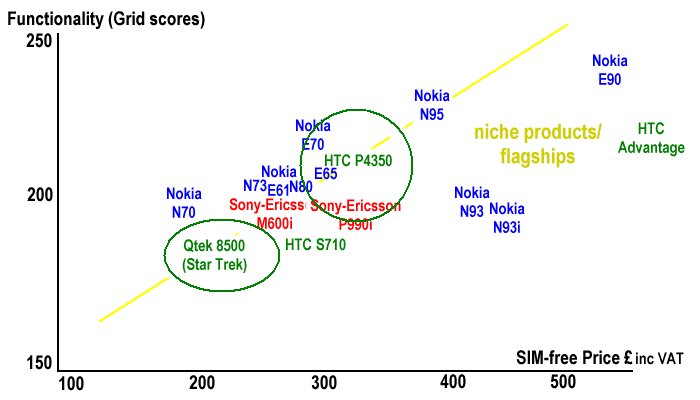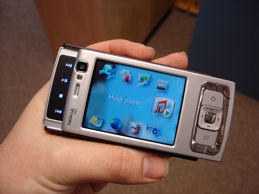
Reviewing the Qtek 8500 (aka HTC's Star Trek) smartphone for Smartphones Show 26 only a week or so after previewing the Nokia E90, I was struck that each represented just about the opposite extremes of the smartphone scale. The Qtek 8500 was in truth little more than a feature phone, with the only distinguising feature really being that you could add Windows Mobile third party applications if you wanted. And it was tiny, less than 100g.
At the other extreme, the Nokia E90 is over 200g, very large for a 'phone' but opening up to give you an 800 pixel wide display and full keyboard. Not to mention a very full built-in software suite and GPS. Quite a contrast.
But, I wondered, how do all the other devices from the various manufacturers and networks fit into the space in between? In plotting the 'functionality vs price' chart below, so as not to make the placement of device names too subjective, I used scores taken directly from the 3-Lib Grid (with default 'average' preferences) and prices taken (SIM-free, including VAT) from the Expansys web site. Yes, there are probably other ways to 'score' each device or to assess its cost (especially for those that are mass market enough to be sold on contract in the high street), but this method at least got me started.

By far the most interesting point is that a great many devices lie on or near the yellow line - showing that there's a direct correlation between how good, functional and effective a device is, and its selling price. Which is actually rather warming to realise - in other words, we're paying a fair price for most products. Even the fabled upcoming N95 is bang on the 'line', which is helpful to know.
Economies of scale do clearly come into the equation though, which explains the premium prices being charged for manufacturer flagship devices like the Nokia N93 and N93i, the HTC Advantage, and perhaps also the Sony Ericsson P990i and Nokia E90 . Each of these is aimed at very tech-savvy customers with a relatively niche usage pattern. In addition to the extra technology involved, these devices aren't going to sell in the same sort of quantities and so you'd expect to be paying a premium to buy them. Which again is probably fine. If you NEED an HTC Advantage or a Nokia E90 for your business then it's probably not relevant whether it's £450 or £550. What matters is the capability and something that's reliable.
By the way, the point of the green rings on the chart are to indicate that the Windows Mobile-powered Qtek 8500 and HTC P4350 are simply there as examples of a large range of similar devices, occupying the area inside the circle, with multiple manufacturers and network operators rebranding about a dozen different devices, loosely divided into two distinct classes. The newer HTC S710 and Advantage are examples of a whole new breed of Windows Mobile device and it looks like this world is about to start spreading out a little - notice the way that Nokia's S60 devices are spread around a lot more at the moment.
At the top end of the price/functionality line, there is arguably some overlap with UMPCs (Ultra Mobile PCs), while at the bottom end there's overlap with the higher-specced feature phones (e.g. the Sony Ericsson Walkman and Cybershot models), but the core distinction of being able to run native, compiled third party applications remains, to distinguish 'smartphones' from the rest of the mobile pack.

The Nokia N95 is the first of these ultra-converged mainstream models, of course, and over the next year or so will slide down the 'line' as its price comes down and overall functionality increases. Which partly explains why it's been generating so much interest from so many corners - and why we at AllAboutSymbian have made sure that we've got a number of production N95s booked for in depth review, analysis and tutorials - where the N95 goes, many others will surely follow.
Steve Litchfield, 8 Mar 2007
